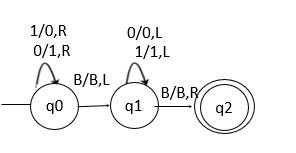
- Trending Categories
 Data Structure
Data Structure Networking
Networking RDBMS
RDBMS Operating System
Operating System Java
Java MS Excel
MS Excel iOS
iOS HTML
HTML CSS
CSS Android
Android Python
Python C Programming
C Programming C++
C++ C#
C# MongoDB
MongoDB MySQL
MySQL Javascript
Javascript PHP
PHPPhysics
Chemistry
Biology
Mathematics
English
Economics
Psychology
Social Studies
Fashion Studies
Legal Studies
- Selected Reading
- UPSC IAS Exams Notes
- Developer's Best Practices
- Questions and Answers
- Effective Resume Writing
- HR Interview Questions
- Computer Glossary
- Who is Who
Draw a Turing machine to find 1’s complement of a binary number
1’s complement means transforming the 0 bit to 1 and the 1 bit to 0.
Let the input be −
| B | 0 | 0 | 1 | 0 | 1 | 1 | 1 | 0 | B |
The output is as follows −
| B | 1 | 1 | 0 | 1 | 0 | 0 | 0 | 1 | B |
Concept
The concept is explained below −
Step 1 − Start scanning the input from left to right.
Step 2 − If the R/W is at 1, then make it 0 and move right.
Step 3 − If the R/W is at 0, then make it 1 and move right.
Step 4 − Repeat the steps given above and we will reach B (blank).
Step 5 − Then move the R/W head all the way to the left without changing anything until it reaches the first character.
Step 6 − The string will be accepted here.
The Turing machine which implements the above-mentioned steps is given below. Here, Q0 is the initial state and Q2 is the final state.

Explanation
q0 state is to replace ‘1’ with ‘0’ and ‘0’ with ‘1’ and it moves to the right, whenever the BLANK is reached, moves towards the left.
Using state ‘q2’ we reach the start of the string, whenever the BLANK is reached, move towards right and reach the final state q2.

